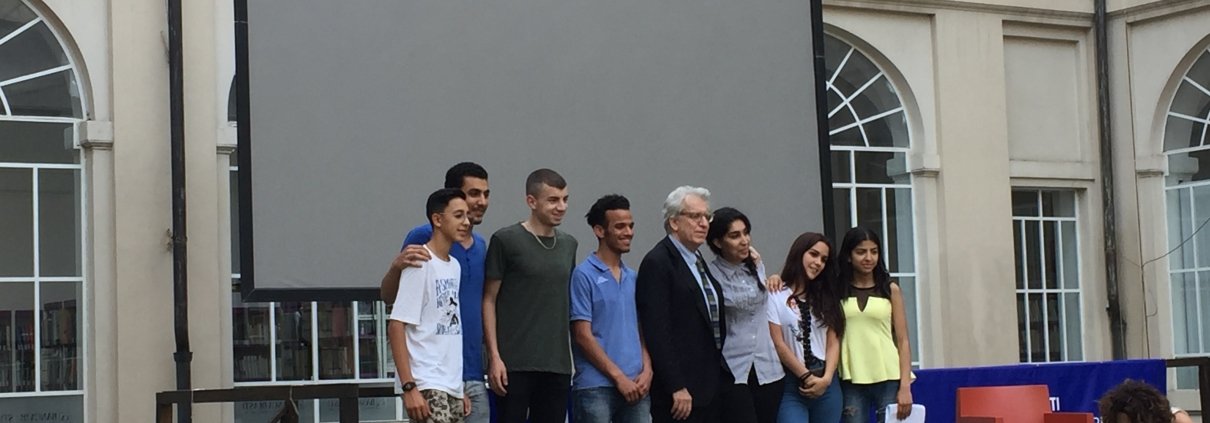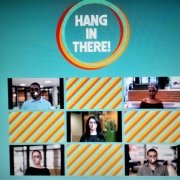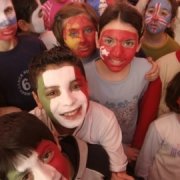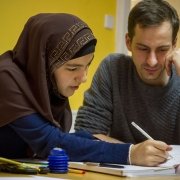CAFFELATTE
Excerpt
In the aftermath of the terrorist attacks at the Istituto Castigliano di Asti, carried out by ISIS in Paris, a school with a high rate of foreign immigrants was set up. The school had a multi-ethnic group of students, educators, cultural mediators and experts. Through comparison and sharing, the pupils concluded that integration is the result of the harmonious encounter between the differences, just like a Caffelatte, a milk and coffee mix. To the culture of death propagated by terrorists, this project responds with the "life" and the construction of bridges between peoples from different cultures.
Narrative, origins and objectives of the initiative
What kind of project is this? Please give a short description (summary) of it.
In 2014, the ISIS and the so-called “Muslim terrorism” largely entered the media agenda and caught people's attention, with a peak due to the Charlie Hebdo shooting in January 2015. This is where the idea for the project was born.
The idea for this project started from a reflection shared among two teachers (Roberta Borgnino and Paolo Maccario), five female students from Italy and Marocco, and a journalist (Laurana Lajolo). Then the project started, involving other teachers and students who were also interested in it. During the 2014/15 school year, a working group was created that included students, teachers, cultural mediation experts, in order to study Muslim second generation students and the problems they encountered in their social context, their contradictory relation with the origin families and the risk of getting involved in terrorism.
Then the group has progressively grown:
- October 2014: 5 students initiated the project
- School Year 2014-2015: a group consisting of 24 students, 4 teachers, 1 journalist, 3 cultural mediators has consolidated
- School Year 2015-16: participation of 35 students, 4 teachers, 1 journalist, 3 cultural mediators
- School Year 2016-17: participation of 40 students, 5 teachers, 1 journalist, 3 cultural mediators, 1 psychologist
- School Year 2017-18 (data updated in April 18): participation of 40 students, 6 teachers, 1 journalist, 3 cultural mediators
The project objectives are listed below:
- Promote the social integration of foreign students, both during school hours and in their spare time, with the aim of fighting exclusion and marginalization
- Promote legal education: shared rules and values, together with respect towards the other, are the basis for inclusiveness
- Support second generation students, above all Muslim ones, to cope with their double/swinging cultural identity
- Promote historical and multi-cultural mutual knowledge as a tool against isolation, conflict, openness to terrorism
- Develop a collaboration network, including multi-discipline teachers, other schools and associations in the area, resident migrant families and asylum-seeking migrants.
The main target of the project is the Castigliano School students, in particular foreign students, second generation students, Muslim students, Italian students, and migrants. Castigliano is a “professional school”, providing training for quick entry into the labor market in the sectors: social and health services, maintenance and technical assistance (electrical, electronic, mechanical), fashion and clothing. Due to this kind of training offer, it attracts a high presence of foreign students. Worth mentioning is the relevant attendance of Muslim female students interested in training in “fashion and clothing”.
The target group evolved out of the school itself, to migrant families and refugees based in the area.
SIZE/SCOPE: 40 students per year
Please tell us why, in general, this project is considered a successful one?
Some success indicators are listed below:
1) The spontaneous participation of students (especially foreigners) to the project proposal and the enthusiasm shown in all phases of the work.
2) The purposeful dialogue between students from different cultures and ethnic groups
3) The overcoming of stereotypes within the group (and the school)
4) The need for young people belonging to the second generation of Islamic foreigners in Italy to express their doubts, their uncertainties, their difficulties in living with a conflict between the culture of belonging and the new Western culture
5) Relationships with external players based in the area, with organizations, associations that deal with migrants and appreciate the project for the value it has in the educational process in terms of integration.
6) The sharing of life experiences with migrants living in the area
7) The project outputs: theatrical shows, collection of life stories, storytelling for elementary school pupils
8) Dissemination of the project message in the area
9) School performance improved
10) School drop-out rates reduced
And why would you consider it a grass-roots initiative?
The project originated from an idea shared between two teachers of the school (Roberta Borgnino and Paolo Maccario), Italian and Moroccan students and a journalist (Laurana Lajolo).
What challenges needed to be solved in this project?
The challenges that Caffelatte encountered were mostly about cultural differences:
1. The culture of foreign students. It has been found that some families had difficulties in the participation of daughters in meetings outside the school. Complex mediation action has always been necessary.
2. The stereotypes and the superficiality that often prevents to formulate an independent judgment. Some Italian students, conditioned by prejudice that characterize the group or the family, refuse to take part in project activities that involved the entire class.
3. The position of some teachers who do not share the aims of the project or who do not consider it of significant importance and which, consequently, do not facilitate the participation of students in the activities.
Is this initiative based on any particular theoretical framework? Which one?
Project keywords are: diversity, differences, integration, identity, racism, citizenship. No specific framework is adopted.
(Appendix) Is your intervention standing on its own or is it a part of a bigger and more holistic approach?
It is an initiative that stands on its own.
Please describe the group(s) intended as beneficiaries of this initiative
Why has this group (have these groups) been chosen?
The target group was formed on a voluntary basis: it started out with 5 students - Italian and foreign, but it has grown rapidly to 24 students. Volunteer students were chosen among the ones who already worked actively at the student desk, active for years, used to foster working in a group, creating moments of reflection, listening.
The group increases every year to encourage integration within the entire institute.
Could you please tell us something about the relative size of the (of each) target group, within the school/university population, region and/or country?
Caffelatte Group
Initially a group of 5 students in October 2014
2014-15 - a group of 24 students is consolidated in February 2015 + 4 teachers, 1 journalist, 3 cultural mediators
2015-16: 35 students + 4 teachers, 1 journalist, 3 cultural mediators
2016-17: 40 students + 5 teachers, 1 journalist, 3 cultural mediators, 1 psychologist
2017-18: 40 students currently + 6 teachers, 1 journalist, 3 cultural mediators, 1 psychologist
____________________
Age: 14-20 years
Gender: Male 50% and Female 50%
60% foreigners - 40% Italian countries: Morocco, Egypt, Albania, Ivory Coast, Ghana, Brazil
Population Institute: 900 students - 35% with migration background
Which social characteristics are taken into account and what is the geographical area covered?
The group presents precise social characteristics: 1) foreigners, but also Italians, who share problematic family situations, living in deprived neighborhoods where stereotypes are rooted, often characterized by xenophobic behavior. 2) Italian and foreign students who have already developed a cultural process of growth and an intent to bring their experience to their peers and students from other schools. Students participating in the project belong to different religions: mostly Muslims and Catholics, but also Orthodox and some who are indifferent to religious discourse (many of them atheists).
The geographical area concerns Italy, Africa, and the Balkan area in particular
On which level is the project implemented?
The Caffelatte proposal achieved the aim of demonstrating how the school can act as facilitator in the integration process aimed at combating terrorism and racist violence.
A unique experience where students learn to talk, interact, reflect, to dismantle stereotypes, and to make their own authentic values of life that are above all religious beliefs and every culture.
Every year the project aims to develop a different aspect. Migrants participate in discussion groups and events, for example at the Caffelatte Day.
The fourth phase of Caffelatte is the 'Legamidipace' (Links of Peace) project that were implemented in the 2017-18 school year. The students and former students who have already taken part in the previous editions, together with the new students who will become part of the group, will act as tutors sharing their skills with a group of foreign migrants (men and women) in a workshop aimed at creating products resulting from the contamination between different cultures and the organization of events open to the territory. The workshop activities will alternate with moments of study and reflection.
A workshop is planned for the 2018-19 school year, which is particularly aimed at the fashion course (one of the teaching courses at the school), to involve women refugees from the AGATON association. Other teaching courses at the school (mechanical, electrical, etc.) may also be affected later.
Please describe the political and socio-economic factors that you believe have been important enablers for your initiative
Did the initiative have political support?
The initiative is supported by two departments of the Municipality of Asti: the Department of Culture and the Department of Education.
How did it fit with local, regional or national policies?
Who are the stakeholders supporting the initiative?
The Caffelatte project involved many actors outside the school: Diocese of Asti (with an event on the theme of integration promoted by the cultural project of the diocese of Asti called Courtyard of Doubters ); Cultural mediators (part of the group); the Municipality of Asti (Asti theater - Project Passpartout (cultural review sponsored by the library) - cooperatives, migrants - Other schools of the Province of Asti
Are there particular demographic changes present that are influencing the project?
Migration, second generation, Muslim migration, integration processes, growing autonomy of Muslim women, Muslim second generation women + economic crisis requires the creation of new competences, new jobs
What is the institutional strategy and culture of the (educational) organization?
The Castigliano school pays a lot of attention to inclusion and integration due to a high percentage of foreigners within the educational institution - more info here (only available in Italian language https://www.iiscastigliano.it/didattica/ptof/)
To what extent does the initiative have an influence on institutional policy (or potential influence) of the (educational) organization?
The project has been growing in terms of involved students and beneficiaries and in term of visibility. It has opened to other schools and generated several follow-ups, even in different level of schools. No influence on policy or on educational organization can be stated.
(Appendix) Is there public support for your initiative and the issue it addresses?
The success of the project is due to primary factors that can be described as follows:
1. The presence of a Student Desk that fosters dialogue among students, and stimulates the design related to issues that meet the needs of the classes.
2. A suitable space intended for listening, analyzing the problems of Italian and foreign students with the presence of a psychologist.
3. The importance attributed to the practice. Voluntary activities of solidarity, which engage students of different ethnic groups to promote integration, overcome distrust and fear of being 'different'
4. The novelty of the project, especially for those who have experienced situations of isolation or discrimination in the past, not having the strength to report missing a trusted interlocutor (a peer group) who they can turn to.
(Appendix) What other factors do you think have been important for the success of this initiative?
Please describe the overall initiative design and the methods and tools used to reach the goals
Please describe the specific activities carried out.
What were the key roles (teacher, student, management team etc.) within the project?
Teachers: project management, relations with local institutions
Students:
- 2-hour weekly meetings, from October to June, after school hours, aimed at study / discussion / laboratory work. For the duration of the project.
- 2-hour weekly meetings, from October to May, during school hours, several disciplines, addressed to IV and V classes (18 and 19 years old respectively), aimed at study / discussion / laboratory. This has started during the school year 2016-17
- theater group, meeting 2 to 3 times per week, after school hours, in May and June, addressed to prepare and rehearse the theatrical performance
Cultural mediators: support during interactions
Psychologist: reflection and debate about the theme of difference ("il diverso”)
What ideas, tools, theories, models, methodology (etc.) have been used to reach the goals?
1) Cooperative learning and small group learning
2) Peer tutoring
3) Storytelling
4) Lab to produce videos and ODD product
5) Mediation Pedagogy
What are the final revenues of the project?
Caffelatte provided the following final revenues:
1) The spontaneous participation of students (especially foreigners) to the project proposal and the enthusiasm showed in all phases of the work
2) The purposeful dialogue between students of different cultures and ethnic groups
3) The overcoming of stereotypes within the group (and the school)
4) The need for young people, belonging to the second generation of Islamic foreigners in Italy, to express their doubts, their uncertainties, their difficulties in living the delicate moment of confrontation between their own culture and the new Western culture
5) Relationships with the territory, with organizations, associations that deal with migrants and reporting the project for the value it takes in the educational process in terms of integration
6) The sharing of life experiences with migrants present in the area
7) The realized products (theatrical show, the collection of life stories, a fable for elementary school students, storytelling, etc.)
8) Dissemination of the project message on the territory
9) The relationship with families has also improved. There was more involvement of family members - especially in the organization of events. Parents particularly closed to any form of change have begun to give more freedom to their daughters, communicating more openly with the school (all documented - video)
10) Closely connected to the school-to-work project, Caffelatte has allowed and will continue to allow students to develop specific competencies in the following degree course and transversal skills:
- improvement of the class climate
- overcoming conflicts
- overcoming the fear of being "different"
Please describe if your project ensured its sustainability
If so, how did you ensure the short-term impact of the project?
It is based on voluntary participation and motivation
And how did you ensure the long-term impact of the project?
It is based on voluntary participation and motivation
Has your project been replicated elsewhere?
The experience of schools has been a success; many teachers and educators appreciated the work of our students and asked for their support and advice.
Initiatives of other schools sprout from the model of Caffelatte:
- Technical Secondary High School "Artom" of Astu, where, after a training period at Castigliano Institute, a group of students led by some teachers, gave life to a Student Desk. Their main concern is inclusion by taking care of the disciplinary didactic aspect (the tutors experience difficulties to meet the students during extra-curricular hours, like our peer educator at our desk).
- Primary school of Serravalle d'Asti (first class 'Cheerful children' led by teacher Giampiero Monaca) who has been working with us for two years. In this case, the relationship with foreigners is of primary importance, especially on laboratory level, considering the presence on the territory of refugees.
- Another primary school IC3 of Asti is a partner in the project 'One for all, all for one' where some actions of the Caffelatte project are shared.
Please tell us about the resources used in this initiative
What was the budget for the initiative?
It is based on voluntary participation and motivation
How much did the initiative depend on volunteers?
The entire project
How were the costs perceived by the public/the sector/other stakeholders?
To what extent did the initiative achieve its objectives?
Please describe the evidence to support the success of your initiative.
The Caffelatte project promoted a culture of inclusion through the abatement of racist barriers and the support of perceived "different" others, fostering an intensification of relations with other entities of the territory. Moreover, there was an improvement of school results as follows:
% rejected a.s. 2015-16 17%
% rejected a.s. 2016-17 13%
% rejected a.s. 2071-18 12%
Drop-out rate decrease: from 2.4% to.s 2016-17 to 1% a.s. 2017-18
Did the intervention lead to any unintended (positive) outcomes?
Participation of other students in the initial group, their motivation and success stories
The incentive to find new paths and strategies
Participation for two editions at GJC (Global Junior Challenge) - 2015 and 2017 and selection among the finalist projects.
What indicators (quantitative and qualitative) have you measured to demonstrate success?
Analysis of expected results
Activity report carried out
Questionnaires and monitoring
(Appendix) How did you evaluate/monitor this intervention?
The results of the CaffeLatte project are demonstrated and monitored by quantitative and qualitative results:
1) The spontaneous participation of students (especially foreigners) to the project proposal and the enthusiasm showed in all phases of the work.
2) The purposeful dialogue between students of different cultures and ethnic groups
3) The overcoming of stereotypes within the group (and the school)
4) The need for young people, belonging to the second generation of Islamic foreigners in Italy, to express their doubts, their uncertainties, their difficulties in living the delicate moment of confrontation between the culture of belonging and the new Western culture
5) Relationships within the territory, with organizations, associations that deal with migrants and reporting the project for the value it takes in the educational process in terms of integration.
6) The sharing of life experiences with migrants present in the area
7) The realized products (theatrical show, the collection of life stories, a fable for elementary school students, storytelling, etc.)
8) Dissemination of the project message on the territory
9) School performance
10) School drop-out
INDICATORS
1) The presence of students in meetings outside school hours without any obligation. The number of participants in the group - internal and external
2) The willingness to listen - observations within the class
3) Openness to dialogue in class (no incidents of intolerance occurred) - Observations within class - Questionnaires
4) Student statements about the importance of shared work - Stories
5) Participation of migrants in the initiatives - number of participants in Caffelatte Day events
6) The declarations of the external staff who took part in the meetings - number of participants in the events and STORIES
7) Press statements following the presentation of the video and the project by the students who are the protagonists of the course. The mental map of project activity collection.
8) Press review
9) School results - Improvement in grades
10) Abandonment rate - Decrease in number of drop-outs




 Interkulturelles Mentoring
Interkulturelles Mentoring




